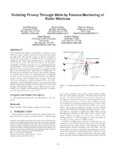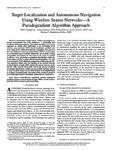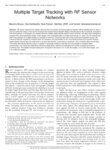Filters: Department: "Computing, School of" School Or College: "College of Engineering" Collection: "ir_uspace"
1 - 25 of 19
| Creator | Title | Description | Subject | Date | ||
|---|---|---|---|---|---|---|
| 1 |
 |
Riloff, Ellen M. | Automatically constructing a dictionary for information extraction tasks | Knowledge-based natural language processing systems have achieved good success with certain tasks but they are often criticized because they depend on a domain-specific dictionary that requires a great deal of manual knowledge engineering. This knowledge engineering bottleneck makes knowledge-based ... | Information extraction; Dictionary construction; Knowledge-based systems; AutoSlog; Domain-specific dictionary | 1993 |
| 2 |
 |
Wehrli, Robert | ARCAID: The ARChitects computer graphics AID | ARCAID?The ARChitect's Computer Graphics AID?is one part of a two-part research program at the University of Utah under the direction of David C. Evans. ARCAID is a specification for the organization of computer processes including data and procedures for the use of architects, engineers, and other... | ARCAID | 1970 |
| 3 |
 |
Riloff, Ellen M. | Corpus-based bootstrapping algorithm for semi-automated semantic lexicon construction | Many applications need a lexicon that represents semantic information but acquiring lexical information is time consuming. We present a corpus-based bootstrapping algorithm that assists users in creating domain-specifi c semantic lexicons quickly. Our algorithm uses a representative text corpus for ... | Bootstrapping algorithm; Lexicon construction | 1999-06 |
| 4 |
 |
Kasera, Sneha K. | Violating privacy through walls by passive monitoring of radio windows | We investigate the ability of an attacker to passively use an otherwise secure wireless network to detect moving people through walls. We call this attack on privacy of people a "monitoring radio windows" (MRW) attack. We design and implement the MRW attack methodology to reliably detect when a pers... | 2014-01-01 | |
| 5 |
 |
Newell, Martin Edward | The utilization of procedure models in digital image synthesis | Many algorithms have been developed for synthesizing shaded images of three dimensional objects modeled by computer. In spite of widely differing approaches the current state of the art algorithms are surprisingly similar with respect to the richness of the scenes they can process. One attribute the... | Digital image synthesis; Procedure models; Shaded images; Three dimensional objects | 1976 |
| 6 |
 |
Evans, David | Graphical man/machine communications: May 1971 | Final technical report 1 December 1969 to 30 June 1970. | 1971-05 | |
| 7 |
 |
Henderson, Thomas C. | Target localization and autonomous navigation using wireless sensor networks -a pseudogradient algorithm approach | Autonomous mobile robots (AMRs) operating in unknown environments face twin challenges: 1) localization and 2) efficient directed navigation. This paper describes a two-tiered approach to solving these challenges: 1) by developing novel wireless-sensor-network (WSN)-based localization methods and 2)... | 2014-01-01 | |
| 8 |
 |
Evans, David | Graphical man/machine communications: November 1969 | Semi-Annual Technical Report 1 June 1969 - 30 November 1969 | 1969-11 | |
| 9 |
 |
Henderson, Thomas C. | Target-directed navigation using wireless sensor networks and implicit surface interpolation | Abstract-This paper extends the novel research for event localization and target-directed navigation using a deployed wireless sensor network (WSN) [4]. The goal is to have an autonomous mobile robot (AMR) navigate to a target-location by: (i) producing an artificial magnitude distribution within th... | 2012-01-01 | |
| 10 |
 |
Riloff, Ellen M. | Empirical study of automated dictionary construction for information extraction in three domains | A primary goal of natural language processing researchers is to develop a knowledge-based natural language processing (NLP) system that is portable across domains. However, most knowledge-based NLP systems rely on a domain-specific dictionary of concepts, which represents a substantial knowledge-en... | Information extraction; AutoSlog; Across domains | 1996 |
| 11 |
 |
Riloff, Ellen M. | Corpus-based semantic lexicon induction with web-based corroboration | Various techniques have been developed to automatically induce semantic dictionaries from text corpora and from the Web. Our research combines corpus-based semantic lexicon induction with statistics acquired from the Web to improve the accuracy of automatically acquired domain-specific dictionari... | Corpus-based; Text corpora; Domain-specific dictionaries; Bootstrapping algorithm | 2009 |
| 12 |
 |
Susarla, Sai R.; Carter, John | DataStations: ubiquitous transient storage for mobile users | In this paper, we describe DataStations, an architecture that provides ubiquitous transient storage to arbitrary mobile applications. Mobile users can utilize a nearby DataStation as a proxy cache for their remote home file servers, as a file server to meet transient storage needs, and as a platf... | DataStations; Ubiquitous transient storage; Proxy cache | 2003-11-14 |
| 13 |
 |
Henderson, Thomas C.; McMurtry, Patrick; Smith, Philip J.; Voth, Gregory Alan; Wight, Charles Albert; Pershing, David W. | Simulating accidental fires and explosions | The Center for the Simulation of Accidental Fires and Explosions at the University of Utah focuses on providing state-of-the-art, science-based tools for the numerical simulation of accidental fires and explosions, especially in the context of handling and storing highly flammable materials. | Center for the Simulation of Accidental Fires and Explosions; PBX9501; HMX | 2000 |
| 14 |
 |
Painter, James S. | Radioptimization - Goal based rendering | This paper presents a method for designing the illumination in an environment using optimization techniques applied to a radiosity based image synthesis system. An optimization of lighting parameters is performed based on user specified constraints and objectives for the illumination of t h e envir... | Radioptimization; Illumination; Optimization; Lighting parameters; Radiosity based image synthesis | 1993 |
| 15 |
 |
Evans, David | Graphical man/machine communications: June 1972 | 1972-06 | ||
| 16 |
 |
Silva, Claudio T. | ISP: An optimal out-of-core image-set processing streaming architecture for parallel heterogeneous systems | Image population analysis is the class of statistical methods that plays a central role in understanding the development, evolution, and disease of a population. However, these techniques often require excessive computational power and memory that are compounded with a large number of volumetric inp... | 2012-01-01 | |
| 17 |
 |
Venkatasubramanian, Suresh | Multiple target tracking with RF sensor networks | RF sensor networks are wireless networks that can localize and track people (or targets) without needing them to carry or wear any electronic device. They use the change in the received signal strength (RSS) of the links due to the movements of people to infer their locations. In this paper, we cons... | 2014-01-01 | |
| 18 |
 |
Logan, Nelson Stanley | Master schedule building and the flexibly scheduled school | This paper contains a model of a technique for increasing the quality of educational and instructional opportunity for all students. This model is developed around the flexible or modularly scheduled secondary school. Also included is a procedure containing a computer program, with which the adminis... | Flexible scheduling; Flexibly scheduled school; Modularly scheduled school | 1970 |
| 19 |
 |
Fuchs, Henry | The automatic sensing and analysis of 3-D surface points from visual scenes | Described are the design and implementation of a new range-measuring sensing device and an associated software algorithm for constructing surface descriptions of arbitrary three-dimensional objects from single or multiple views. The sensing device, which measures surface points from objects in its ... | Range-measuring; Sensing device | 1976 |
1 - 25 of 19
